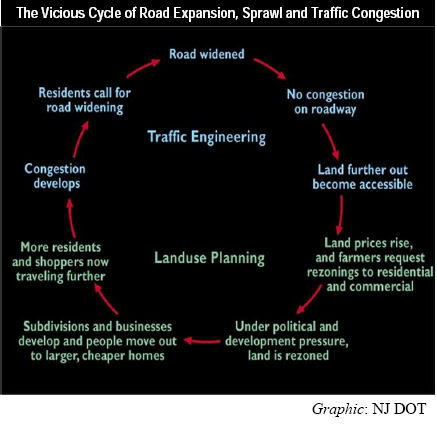
There was a saying my mentor Janine Bauer used to tell me when I was back fighting wasteful highway projects in New Jersey. "The public process for highway expansion isn't over until the road is built." What she meant was that the monied interests in building expensive highway projects won't stop no matter how often they are rebuked by oversight agencies or judges and will always find a new way to push forward.
No where is this better illustrated than in the case if the proposed Foothill South (SR 241) project in Orange County. The 16-mile project was rejected by the California Coastal Commission, a state agency that reviews projects that could impact environmentally sensitive areas around the coast and the Federal Commerce Department back in 2008. We should note that both California and the federal government were under Republican administrations at the time.
But that didn't stop the TCA from trying again. Back in October, the agency proposed a new plan to build the road extension without running afoul of those pesky environmental laws that so hamper visionaries who look at a forest and see a great place for a new road. Instead of building the entire road all at once, they're going to build it, and get it environmentally cleared in phases.
First up is a four mile extension of the SR 241 that would terminate "somewhere in the vicinity of Ortega Highway, though further studies and engineering would have to determine what street north of the highway the segment would feed onto."
Back in 2008, the Foothill South Toll Road debate was all the rage in transportation planning in Southern California. Nearly 6,000 people attended a public hearing hosted by the Commerce Department with L.A. Times reporter Steve Hymon liveblogging the event in advance of his coverage. Later, in a pretty shocking example of government abuse, the TCA sent out hundreds of thousands of mailers to residents attacking the opponents of the expansion project.
Not surprisingly, the same opponents to the project in 2008 are opposed to it now. In the leadup to the TCA decision to move forward with a four mile segment, the NRDC blasted the project at Switchboard.
To make matters worse, the TCA intends to fund this latest scheme through tolls based on an astonishing prediction of 41,000 average daily trips along the four-mile segment in the year 2035. What the factual basis may be for this estimate along this single section is uncertain – the TCA hasn’t said – but it may have more to do with the amount the TCA’s bankers estimate would be required to green light construction than the amount reasonably expected in actual ridership.
Whether the TCA's newest proposal has a chance to meet legal muster will most likely depend on whether or not it can convince oversight agencies that the 41,000 average daily trips is a real number. The federal government frowns on segmenting projects to pass environmental muster, but does allow for small versions of large projects to be permitted separately if the project has value on its own, according to "Environmental Law," a guidebook for environmental lawyers.
The project has also drawn the scorn of the Los Angeles Times, which lampooned TCA in an editorial right before the end of the year.
The toll-road agency isn't barred from trying again with a different route, but that's not easy. If the southern end of the road were moved a little to the north of San Onofre State Beach, it would pass through the built-out areas of the city of San Clemente. Moved a little south, it would pass through Camp Pendleton, and though the agency is talking to the U.S. Marine Corps about possible options, camp officials have been consistently resistant to civilian developments in their midst.
The Times editorial also notes that the TCA makes no bones that the road is necesary to support a 14,000 unit development in Rancho Mission Viejo. This was apparently news to the developers who were trying to build a community that didn't cater to the car-reliant and did cater to retired residents, those least likely to need a toll road to meet their commuting needs.
This new debate has many sad aspects to it. Perhaps the saddest is a quote from a Patch article from a Taxpayer's Association supporting the project.
“Toll roads are a prodigious gift to taxpayers,” he said. “They are at the top in terms of utility to taxpayers; if we don’t use them, we don’t pay for them. They enable free-flowing traffic which keeps the air clean and creates wealth.”
I wonder who does pay for publicly owned toll roads that nobody uses? But as is so often the case, when it comes to the rush to support a massive highway projects, it's not the facts that rule the public debate, but empassioned pleas that don't always make a lot of sense.







